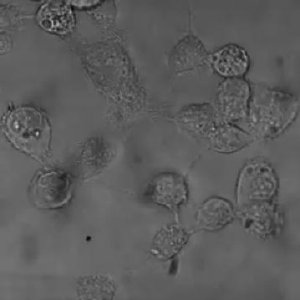Feb 8 2010
Scientists from the U.S. Department of Energy's Argonne National Laboratory and the University of Chicago Medical Center are shaking up the world of materials science and cancer research on the cover of the February 2010 issue of the journal Nature Materials.

Brain cancer is notoriously difficult to treat with standard cancer-fighting methods, so scientists have been looking outside standard medicine and into nanomaterials as a treatment alternative.
"Our mission is to develop advanced ‘smart’ materials with unique properties," said Elena Rozhkova, a nanoscientist with Argonne's Center for Nanoscale Materials. "These efforts are directed to the improvement of the national quality of life, including creating novel medical technologies."
A team of scientists, including Rozhkova, Dong-Hyum Kim, Valentyn Novosad, Tijana Rajh and Samuel Bader from Argonne, and Maciej Lesniak and Ilya Ulasov from the University of Chicago Brain Tumor Center, developed a technique that uses gold-plated iron-nickel microdiscs connected to brain-cancer-seeking antibodies to fight cancer. The microdiscs are an example of a nanomagnetic material and can be used to probe cell mechanics and activate mechanosensitive ion channels, as well as to advance cancer therapies.
The discs posses a spin-vortex ground state and sit dormant on the cancer cell until a small alternating magnetic field is applied and the vortices shift, creating an oscillation. The energy from the oscillation is transferred to the cell and triggers apoptosis, or "cell suicide."
Since the antibodies are attracted only to brain cancer cells, the process leaves surrounding healthy cells unharmed. This makes them unlike traditional cancer treatment methods, such as chemotherapy and radiation, which negatively affect both cancer and normal healthy cells.
"We are very excited about this melding of materials and life sciences, but we are still in the very early research stages," materials scientist Valentyn Novosad said. "We are planning to begin testing in animals soon, but we are several years away from human trials. Everything is still experimental."
Along with continued testing and research of the treatment, scientists also have to examine any possible side effects that have been so far unseen in the laboratory.
"The use of nanomaterials for cancer treatment is not a new concept, but the ability to kill the cells without harming surrounding healthy cells has incredible potential," Rozhkova said. "Such a topic can only be approached with the expertise of markedly differing disciplines such as physics, chemistry, biology and nanotechnology and can make a great impact in important areas of science and modern advanced technologies."
Nano-discs destroy cancer cells